Special heating is needed! The best heating options in a wooden house
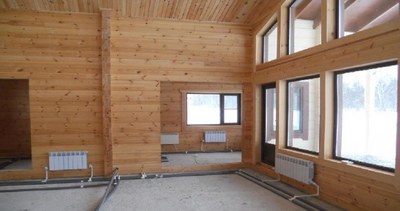
City dwellers are trying to move from the stuffy city closer to nature, to the land, buying houses in villages and towns.
When moving into a new home, the question arises about choosing economical and efficient heating.
There are many options for heating a wooden house, among which you can choose the best option for any type of home.
Types of heating

Home heating options can be divided by the type of energy source consumed. into three types:
- gas;
- electrical;
- stove.
Each of them has its own advantages and disadvantages.
Gas
When installing this type of heating, the heat source is liquefied or natural gasBoiler and convector heating systems are used.
In the first option, the gas, burning in the boiler, heats up antifreeze circulating through pipes and radiators. The device is installed in a place convenient for the owners, in a small house this is usually the kitchen. In a two-story cottage, for example, a special room is allocated for the equipment - a boiler room. Radiators are hung on the walls of the heated rooms. It is also possible to install a warm water floor.
Reference. Double-circuit gas boilers will provide the house not only with heat, but also with hot water.
With a convector heating system, a convector stove is installed in the room, which directly heats the space.
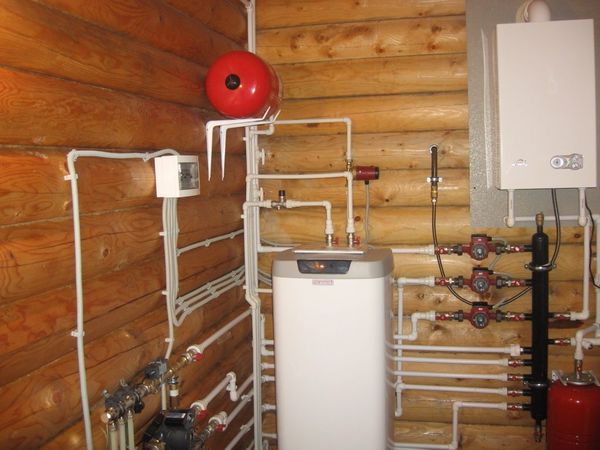
Photo 1. Floor-standing gas heating boiler installed in a wooden house. Heats the coolant that enters the pipes.
The positive properties of this scheme The low cost of the equipment and the possibility of using not only natural gas, but also liquefied gas from cylinders can be attributed to this. The negative qualities include: uneven heat distribution in the room where the convector is located, as well as the need to install the device in each room where heat is required.
Installation
Heating devices that run on gas are installed on a non-combustible base. When mounted on a wall, a spacer is constructed between the wooden wall and the device. a gasket made of sheet metal with an asbestos backing. To remove carbon monoxide from the room, boilers and convectors are connected to the chimney.
Advantages gas heating:
- low cost of energy source - gas;
- small dimensions of the equipment;
- when installing a gas boiler, water radiators are mounted along the perimeter of the walls, thereby ensuring uniform heating of the room;
- Boilers and convectors are controlled automatically, shutting off the energy supply during interruptions in gas or electricity supply.
Flaws gas heating:
- the gas is explosive;
- installation of boilers and converters should be carried out only by specialists;
- high cost of heating devices.
Electrical
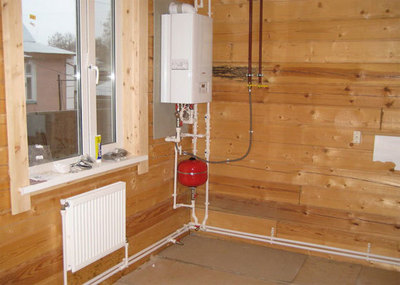
The house can be equipped with electric heating. Boiler heating systems, convector or heating and warm floors are used.
In an electric boiler, the heating elements interact with antifreeze, which distributes heat through pipes and radiators.
In rooms with a concrete base, it is possible to install a water floor heating system. The automation unit maintains the set temperature in the room.
With a convector heating system, a convector radiator or heater is hung in each room, directly heating the air. Modern insulated heating elements do not burn oxygen and provide rapid heating of the room. Automatic control units have an energy-saving mode, allowing the temperature of the house to be maintained at the mark during the long absence of the owners. plus 5 degrees, maximum heating temperature 65 degrees will not allow you to get burned when touching.
If the device falls or overheats, the automatic Instantly de-energizes the device.
Underfloor heating systems — the latest industrial development. A heating cable or film is laid under the floor covering on a special base, heating the room through the floor. This system distributes heat evenly and creates a comfortable temperature zone for a person.
Installation
Installation of electric heating is relatively simple and can be done independently. Convectors, radiators, and a hot water boiler are hung in a place convenient for the owners. Installation of water heating is carried out using polypropylene pipes by welding. The warm floor is laid on a special base, covered with tiles or laminate on top.
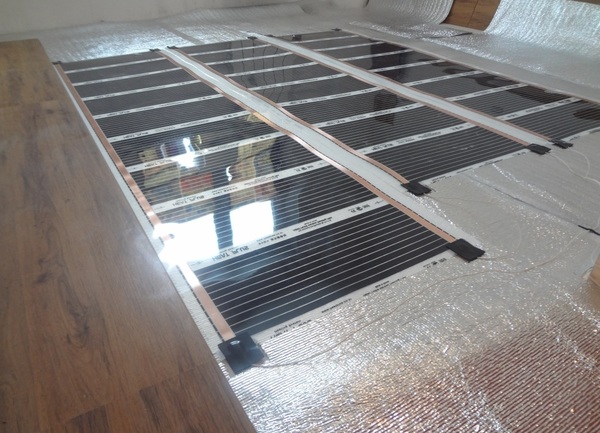
Photo 2. Installation of an electric infrared floor. A special film is used for heating, which is covered with laminate on top.
Advantages electric heating:
- ease of installation of the heating system;
- low cost of devices;
- low requirements for location;
- electrical appliances do not make noise when operating and do not require an expensive ventilation system;
- Electric heating devices are controlled by automatic systems that switch them off in the event of a malfunction or power supply failure;
- the possibility of self-installation of the system.
Flaws electric heating:
- high cost of electricity;
- To ensure uninterrupted operation of the system, a stable voltage of the electrical network is required;
- To heat a large house, you need reinforced electrical wiring.
Stove
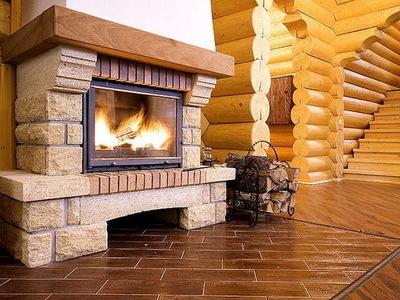
With this heating the room is heated by the heat of burning woodThe equipment operates even in the event of interruptions in the supply of gas and electricity.
Distinguish heating and cooking ovens, fireplaces and ovens with a water boiler.
Based on the material The design can be made of metal or brick.
In a heating and cooking stove, the burning fuel heats the walls of the equipment. Additionally, during the combustion process, Cooking stove.
Reference. At the customer's request, in addition to the stove, a built-in oven oven, smokehouse and water tank.
In a fireplace, an open fire heats the surrounding airIf special grates and devices are available, the equipment can be used for cooking.
The peculiarity of a stove with a built-in water boiler is that the main heat output occurs when it is fired up comes from the liquid poured into the boiler, which heats radiators hung on the walls of the house through a system of pipelines.
Installation

Laying the stove - a difficult process, but one that can be mastered independently.
Sand and clay for mortar can be dug up in a field or ravine; the cost of bricks is low.
Brick layout patterns in a row for self-laying can be found in books on stove making or downloaded from the Internet.
Metal stoves weigh little and are installed on the floor of the room, without a special foundation.
Attention! To ensure fire safety, the base of the structure is made of non-combustible materials. Protective screens are installed behind and on the sides of the device. The minimum distance from the walls of the stove to wooden surfaces 50 cm (to the protected wall of the room -20 cm).
Particular attention is paid to chimneys, the material from which they are made, must be non-flammable And have low thermal conductivity. Brick chimneys, sandwich systems, ceramic and vermiculite pipes have such properties.
A good option for protecting floor and wall coverings is ceramic tile cladding. A plasterboard or asbestos cement sheet is placed under the cladding. Installation is carried out using heat-resistant mastic.
Advantages stove heating:
- firewood or peat briquettes are inexpensive fuel;
- the structure can be assembled independently;
- A brick oven retains heat for a long time.
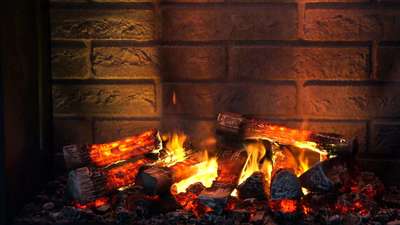
Flaws stove heating:
- chimneys require periodic cleaning;
- the stoves are inert in terms of heat release and therefore take a long time to warm up the room;
- massive models take up a lot of space in the house;
- Cracks in the stove masonry can lead to a fire.
Heating a wooden house with minimal costs
The use of infrared heaters, the operating principle of which is based on modern scientific developments, is considered an economical option.
Infrared heaters
Infrared heaters are powered by electricity. During operation, they emit infrared rays that heat the surface they hit. Thus, the heat emitted from the floor and interior items, distributed evenly, ensuring comfort for human living.
Infrared heaters are produced in ceiling, wall and floor versions, the power of the devices is from 20 W to 2 kW. To maintain a constant temperature in the heated room, models are equipped with temperature sensors, some operate from remote controls.

Photo 3. Infrared heater installed on the ceiling in a wooden house. The device heats the room well.
Installation
Installation of infrared heaters is simple and can be done independently. Ceiling models are fixed with special brackets or built into a suspended ceiling system. Wall models are simply hung around the perimeter of the room.
Important! If there are small children in the apartment, heaters installed at an inaccessible height.
Advantages infrared heating:
- Due to their high efficiency, IR heaters are economical;
- fire safety;
- the ability to quickly warm up the room;
- automation allows you to set and maintain the required temperature.
Flaws infrared heating:
- To ensure uninterrupted operation of the system, a stable power supply voltage is required.
Useful video
Watch a video that talks about the features of a heating system in a wooden house.
What is the best way to heat a wooden house?
When choosing the type of heating for a wooden house, do not forget that each of the proposed options for safety precautions requires special conditions for installation. Gas equipment is critical to the tightness of the system, electrical equipment is critical to the cross-section of the cables supplied to the house, and stove equipment is fire hazardous if there are cracks in the masonry. Therefore main criterion to select the heating type - compliance with safety standards.









Comments
Now the downsides: you can’t cook food without lighting the stove, you need to have a supply of firewood, of course, with gas everything is much simpler, but also more expensive.